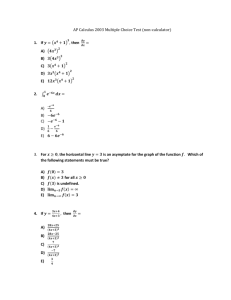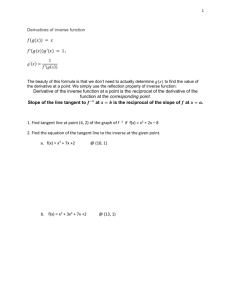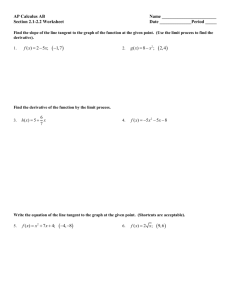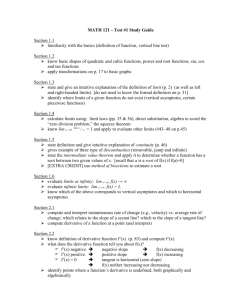The Derivative of Some Basic Functions
advertisement
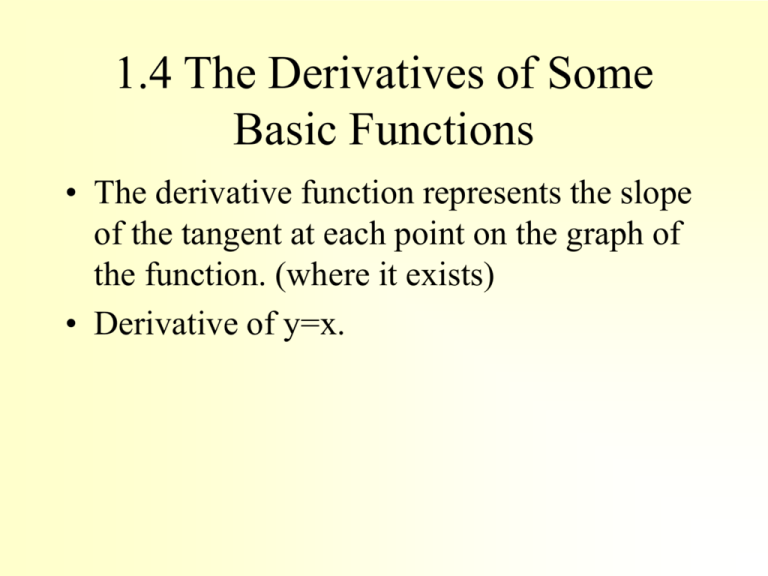
1.4 The Derivatives of Some Basic Functions • The derivative function represents the slope of the tangent at each point on the graph of the function. (where it exists) • Derivative of y=x. Derivative of x y -3 -2 -1 0 1 2 3 9 4 1 0 1 4 9 Slope of tangent at x -6 -4 -2 0 2 4 6 •Slope of tangent at x =2x •y’=2x 2 y=x 2 2 2 2 2 2 Derivative of y=x2 y’=2x • The derivative of y=x2 is y’=2x • See graph. • See rate triangle 4=2x 1 2=2x 1 The instantaneous rate of change of y with respect to x is 2x. Visualize the point moving from left to right along the graph of y=x2 The slope along the tangent is always double the x-coordinate of the point. Derivative of y=x3 x -3 -2 -1 0 1 2 3 9 4 1 0 1 4 9 -27 -8 -1 0 1 8 27 Slope of tangent at x 27 12 3 0 3 12 27 •Slope of tangent at x is 3x2 •y’=3x2 3 y=x -15 6 -9 6 -3 6 3 6 9 6 15 Derivative of y=x3 • The derivative of y=x3 is y’=3x2 • See graph. • See rate triangle The instantaneous rate of change of y with respect to x is 3x2. 3=3x2 1 Visualize the point moving from left to right along the graph of y=x3 . The slope along the tangent is always three time the square of the xcoordinate of the point. Graph of y=x3 and its derivative y ‘ = 3x2 Example 1 • a) Find instantaneous rate of change of y=x2 at i) x=3 ii) x =-2 • b) Interpret graphically. •Solution i) •The derivative of y=x2 is y’=2x. •When x=3, y’=2(3)=6 •y is increasing 6 times as fast as x is increasing when x=3. m=6 Example 1 • a) Find instantaneous rate of change of y=x2 at ii) x =-2 • b) Interpret graphically. •Solution ii) •The derivative of y=x2 is y’=2x. •When x=-2, y’=2(-2)=-4 •y is decreasing 4 times as fast as x is increasing when x=-2. m=-4 Example 2: Determine the equation of the tangent line. • Determine the equation of the tangent to the graph of y=x3 at the point (-2,-8). • Illustrate the results on a graph. •Solution •The derivative of y=x3 is y’=3x2. •When x=-2, the slope of the tangent line is y’=3(-2)2 = 12. •The slope of the tangent is 12. •The equation of the tangent line using y=m(x – p) + q is •y=12(x+2)-8, or y=12x+16. Example 2: Graph • Graph the function and the tangent line. Derivative of y=mx+b • y=x • y=mx • y=mx+b • a) y’=1 • b) y’=m • c) y’=m Vertical Translation Rule • When the graph of a function is translated vertically, the derivative is not affected. • The derivative of y=f(x)+c is y’=f ’(x), where c is any constant. • Example: Find the derivative of y=x2+4. • y’=2x. Vertical Translation Rule Example: Find the derivative of y=x2+4. • y’=2x. Vertical Stretch Rule • When the graph of a function is expanded or compressed vertically, the graph of the derivative is also expanded or compressed vertically. • The derivative of y=cf(x) is y’=cf’(x), where c is any constant. • • • • Vertical Stretch Rule Example: Find the derivative of y=2x3 f(x)=x3 , f’(x)=3x2 y’=2f’(x) , so y’=2(3x2) Or y’=6x2 •When the function is stretched by a factor of 2, the y-values for any x-value are doubled. •That means when the slope is calculated at any point the slope will be doubled. Practice • Find the derivatives of the following functions. 2 •a) y’=3x 3 • a) y=x + 23 •b) y’=-10x • b) y=-5x2 2 •c) y’=12x 3 • c) y=4x -7 •d) y’=7 • d) y=7x 2 •e) y’=-3x 3 • e) y=14 - x f(x)=x2 ;f ‘(x)=2x f(x)=x3 ;f ‘(x)=3x2 If y = f(x) +c, then y ‘= f ‘(x) If y = cf(x), then y ‘= cf ‘(x)


